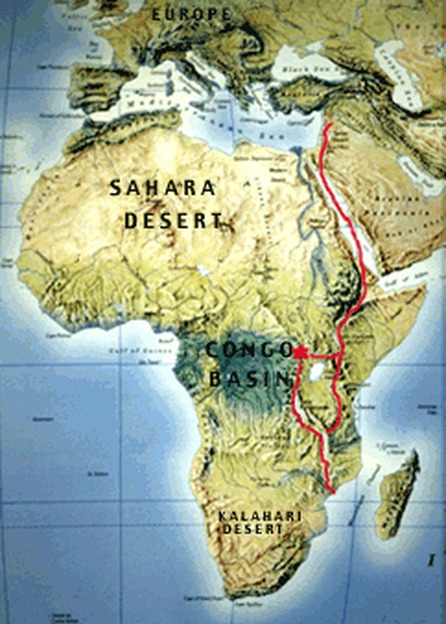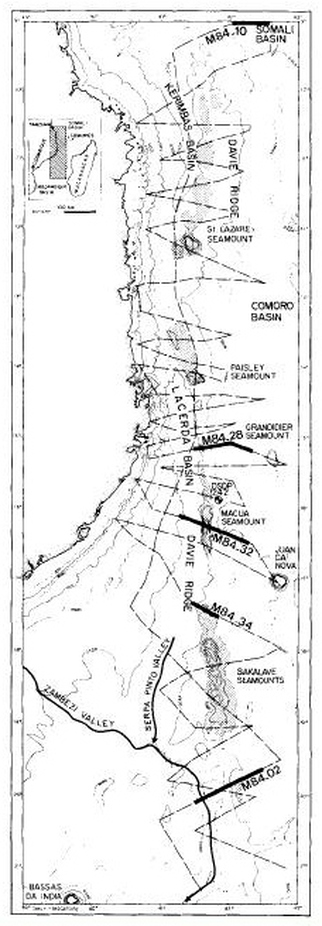A Tectonics Arctile by Ashten Sawitsky
The Great Rift Valley (East African Rift)The East African Rift is a southern rifting arm off the Afar Triple Junction and transects through African countries such as Kenya, Uganda, Rwanda, Zambia, Malawi and subsiding in the Lesotho-Natal, a seismically active area. The African rift is divided into two arms at the Afar Triple junction in Djibouti. Heading northwest, the rift follows the Red Sea Rift until it meets the Dead Sea Transform fault up to Sinai, Egypt. From there, its trajectory becomes the Hula valley separating the Golan Heights and Galilee Mountains. This valley turns into the Beqaa Valley at which point terminates this rifting arm. Towards the northeast, the rift goes through the Aden Ridge in the Gulf of Aden. It then meets the Indian Ridge offshore in the Arabian Sea.
The East African Rift started separating African into two continents around 23 million years ago and has undergone five different chronological rifting stages consisting of many volcanic events. The basement of the rift is layered with dormant and active volcanoes such as Fantelle, Longonot and Moroto (Briggs and Blatt, 2009). The physical separation started occurring in the second stage rifting around 13.5 to 12 million years ago at which point surface fissures appeared (Logatchev et al. 1972). At some places the rift reaches 40 meters wide, is approximately 4 000 kilometers long and some areas, such as Lake Naivasha, reach elevations up to 6135 meters. The African rift’s continental crust has halved its thickness in some areas to about 20 km and some areas are even 100 m below sea level. |
The formation of the African rift is controversial. Logarchev et al. (1972) suggests that the formation of the rift was not necessarily due to tectonic activity, but rather crustal density differences. Others suggest that the rift is formed due to the African megaplume which caused significant mantle deformation (Corti, 2009). Most recently, the rift is said to be controlled by oblique rifting conditions which lead to volcano-tectonic activity that initiated a strong feedback between deformation and magmatism. Initially the displacement of boundary faults caused crustal depression, thinning the lithosphere. Rifting started to occur when mantle source reached the thinned rift depression and began to generate large volcanic activity. This feedback is continually fed by magmatism such as intrusions, small plumes and dykes forcing the thinned lithosphere to act like a mid-ocean spreading center (Corti, 2009).
The afar triple junction
|
The Afar triple junction is a depression consisting of a rift-rift-rift triple boundary associated with the flood basalt magmatism 31 million years ago (figure 3). As stated previously, it is the middle of three rifting segments which all seem to have occurred synchronouly: African Rift, Aden Ridge and the Red Sea Rift. The actual formation of the triple junction did not occur until the Main Ethiopian Rift commenced around 10 million years ago when the whole African Rift stared to separate. This fact marks a significant time gap between the Arabia-Africa separation and the African Rift opening. Therefore the driving forces that caused both divisions are not necessarily related. The Afar triple junction is thought to be created by a magma plume generated in the Earth’s mantle, whereas the African Rift was created via oblique faulting. The intersection of these two geological features is what actually created the “triple junction”. Through plate kinematic data, the triple junction has migrated northeast since its formation (Wolfenden et al., 2004) (Corti, 2009).
|
The Davie Ridge
|
Madagascar is presumably moving southward relative to Africa which is a result from the super continent Gondwana break-up in the late Jurassic-early Cretaceous. The Mozambique continental margin is present between Eastern Africa, Mosambique and Madagascar where the triangular sedimentary basin is divided in two by the Davie ridge. The Davie Ridge is thought to be the morphological manifestation left by the motion of Madagascar where small basement-block displacement occurred during a convergent strike-slip fault. Three distinct phases correlate to the basin formation, activity and future movement. First, is the initial transform margin caused by Madagascar’s southern movement from Africa. Following is the Mascarene basin opening separating India. Finally, is the future movement and separation partially (possibly fully) concurrent with the East African Rift (Mascle et al., 1987).
|
Volcanoes
|
Ol Doinyo Lengai volcano is currently the only active natrocarbonatite volcano in the world. It is situated in the Gregory Rift, part of the East African volcanism rift complex. Due to the composition of the lava (almost no silicon), eruptions are at relatively low temperatures around 510 degrees Celcius and appears black (not red) in fluid state during the day. Its viscosity is much lower than the average volcanic lava and is very unstable at Earth’s surface. Due to the mineral instability, the landscape has weathered and taken on black/grey foundation surrounding the volcano. The magma is thought to have formed from extreme disequilibrium between uranium and thorium series nuclides. When this disequilibrium occurs, it is suggested that the magma formation time and mass balance difference caused a carbonatite exsolution with radium enrichment (Williams et al., 1986).
|
Mountain ranges
Home of numerous mountain ranges with the highest peaks being Kibo in the Kilimanjaro range and Mount Kenya. These mountain ranges are by-products of the African Rift, even though they lay outside of the valley.
References
Briggs, P., Blatt, B. 2009. Ethiopia: the Bradt travel guide. Bradt Travel Guides. p. 450. ISBN 978-1-84162-284-2.
Corti, G. 2009. Continental rift evolution: From rift initiation to incipient break-up in the Main Ethiopian Rift, East Africa. Earth Science Reviews. 96; 1-53.
Levin, H.L. 2005. The Earth Through Time, Eighth Edition. Chapter 7.
Logatchev, N.A., Beloussov, V.V., and Milanovsky, E.E. 1972. East African Rift Development. Tectonophysics, 15: 71-81
Mascle, J., Mougenot, D., Blarez, E., Marinho, M., and Virlogeaux, P. 1987. African transform continental margins: examples from Guinea, the Ivory Coast and Mozambique
Williams, R.W., Gill, J.B., and Bruland, K. 1986. Ra-Th disequilibria systematics: Timescale of carbonatite magma formation at Oldoinya Lengai volcano, Tanzania. Geochimica et Cosmochimica. 50; 1249-1259.
Wolfenden, E., Ebinger, C., Yirgu, G., Deino, A., and Ayalew, D. 2004. Evolution of the norther Main Ethiopian rift: birth of a triple junction. Earth and Planetary Science Letters. 224; 213-228.
Corti, G. 2009. Continental rift evolution: From rift initiation to incipient break-up in the Main Ethiopian Rift, East Africa. Earth Science Reviews. 96; 1-53.
Levin, H.L. 2005. The Earth Through Time, Eighth Edition. Chapter 7.
Logatchev, N.A., Beloussov, V.V., and Milanovsky, E.E. 1972. East African Rift Development. Tectonophysics, 15: 71-81
Mascle, J., Mougenot, D., Blarez, E., Marinho, M., and Virlogeaux, P. 1987. African transform continental margins: examples from Guinea, the Ivory Coast and Mozambique
Williams, R.W., Gill, J.B., and Bruland, K. 1986. Ra-Th disequilibria systematics: Timescale of carbonatite magma formation at Oldoinya Lengai volcano, Tanzania. Geochimica et Cosmochimica. 50; 1249-1259.
Wolfenden, E., Ebinger, C., Yirgu, G., Deino, A., and Ayalew, D. 2004. Evolution of the norther Main Ethiopian rift: birth of a triple junction. Earth and Planetary Science Letters. 224; 213-228.







